There’s a tropicbird under my bed!
By Eric Schroeder
This past spring I spent some time following the progress of a Brewer’s Blackbird family that built a nest on my horse trailer. That concern was part of my larger interest in breeding birds, one cultivated by the Master Birding Program co-sponsored by Golden Gate Bird Alliance that I completed last year. But this summer, when I went to the Great Barrier Reef in Australia to dive, I had coral and fish on my mind, not birds. After all, July is winter there. Little did I think I would find a Red-tailed Tropicbird nesting under my bed.
Actually, I knew from past visits that tropicbirds had nested in front of the reef suite where my wife, Susan, and I stay at the Lady Elliot Island Eco Resort. But, as the sign posted for guests says, the birds nest there from September to May—not in winter. We hadn’t been back for a few years. The sign is now inaccurate. The tropicbirds have started coming twice a year. Their success story is part of a larger story of conservation success on this small coral cay, the southernmost point on the Great Barrier Reef.

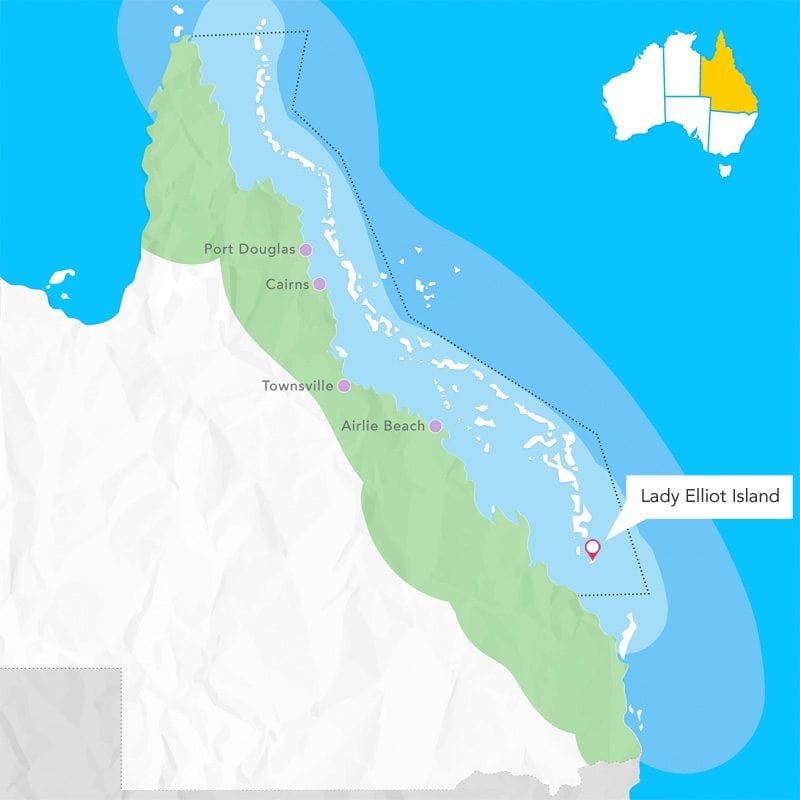
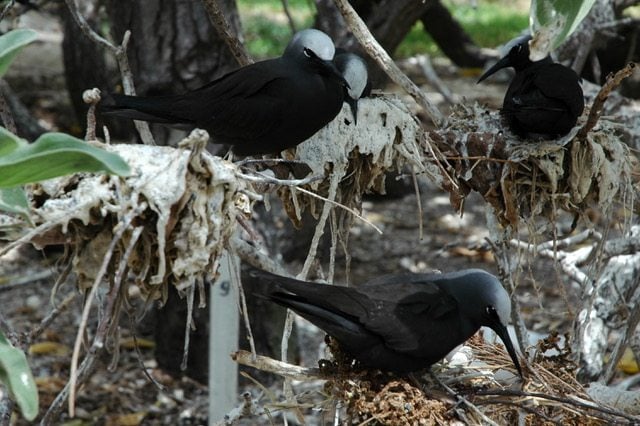
The month of December—summer in the southern hemisphere—is a madhouse for breeding on Lady Elliot. Over 100,000 birds nest on this 110-acre island, so there’s a real competition for choice lots. In front of the unit that Susan and I usually rent, up to twenty pairs of Brown Noddies can be found nesting in a single octopus bush—it’s like a four-story apartment building for seabirds! And the tropicbirds nest on the ground underneath. Shearwaters and several species of terns also nest in great numbers on the island. There’s so much nesting that it generally takes new visitors a couple of days to adjust to the island’s noise level: The sound of birds calling, squawking, and shrieking slows down a bit at night but never completely stops.
But July, the peak of wintertime, is a quiet month here. Other than the Buff-banded Rails, Silvereyes, and House Sparrows that have colonized the island and are permanent residents, other birds can be few. Some Reef Herons, a pair of frigatebirds, a White-bellied Sea Eagle. A flock of terns showed up for a day but moved on. Not a single noddy or shearwater, birds responsible for most of the noise in summer. The lack of birds in winter here is disappointing, really. With one major exception—the Red-tailed Tropicbirds. There aren’t a lot of these—just a few at any given time—but there’s nowhere else on earth you will see them as closely.
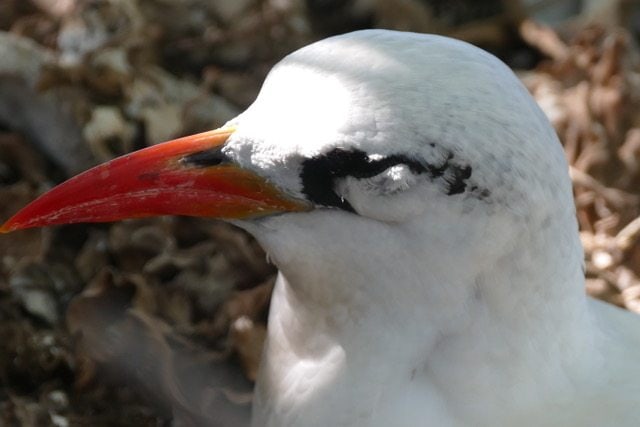
Their scientific name, Phaethon Rubricauda, reflects their distinguishing characteristics. Phaethon was the son of Helios, the Greek sun god, and the name means “the shining one,” a good overall description of the bird’s appearance. Moreover, tropicbirds are amazing flyers, having a wingspan of almost 40 inches, and they are seldom near land except when breeding. As their name suggests, they are found mostly in the topics, in both the Pacific and Indian Oceans—Lady Elliot Island is located 50 miles south of the Tropic of Capricorn. (In Australia, however, they can sometimes be found as far south as the Bass Strait, the body of water that separates Tasmania from mainland Australia.) They are mostly solitary at sea, flying high, alternating between fluttering wingbeats and gliding. They hunt like gannets, diving from great heights, then submerging themselves completely, catching fish.
The second half of their scientific name is a nod to their physical appearance. Overall the birds are silky white with black markings around and behind the eye, and they show a little bit of black on their primaries and tail feathers. Field guilds often suggest that the birds have a “pink flush” but I’d describe it more as a peachy glow.
They have bright orange (and substantial) beaks and black feet and legs. But their defining characteristic is the two bright red streaming tail feathers that extend behind the birds (rubri=red and cauda=tail). The length of the tail feathers—sixteen inches—almost doubles the size of the birds; without the streamers they are eighteen inches in length. Years ago I found one of these streamers on a beach—it’s still the most amazing bird artifact I’ve collected.
And as it happens, the unit my wife and I stayed in is Tropicbird City. One of the interpretive signboards warns people to stay four meters (13 feet) away from the nesting birds. If we were to do that, we’d have to move out. One tropicbird was nesting about ten feet from our front porch. Sitting on our porch we watched her on the “nest”—a shallow scrape in the sand, generally under a bush (but more on that later!) Only a single egg is laid, stone-colored and heavily spotted, which incubates for forty to fifty days.
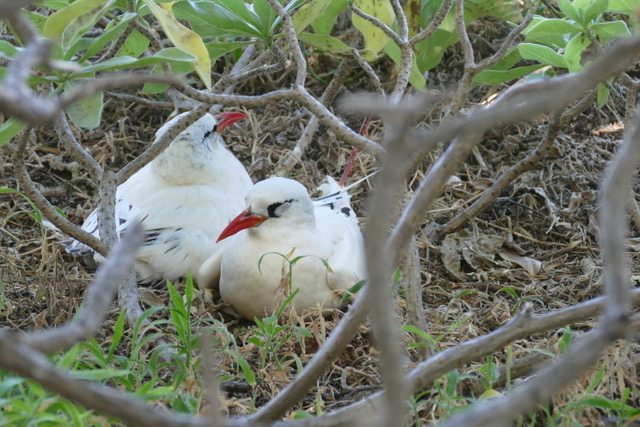
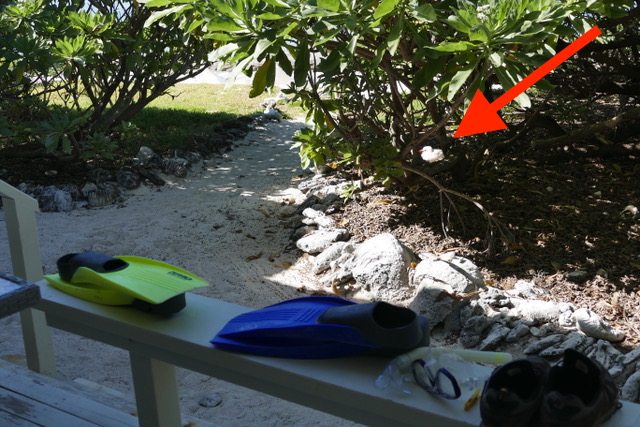
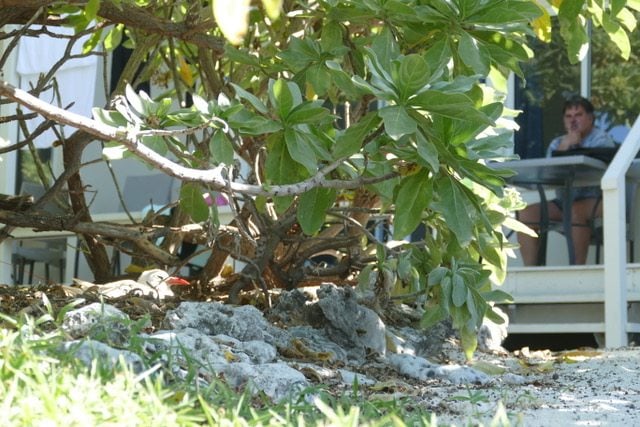
Beautiful flyers, tropicbirds are ungainly on land. When they do come to earth, they circle repeatedly, coming in lower and lower, and then they pull up suddenly about eight feet from the ground and practically crash land. Once on the ground, they don’t walk, they flop and propel themselves on their bellies, pushing off with their feet. (Luckily their nests are usually very close to the landing zone).
And while one partner is landing and moving to the nest, a pair of tropicbirds will carry on an animated conversation—loud squawking or croaking back and forth. These welcome-home conversations can last up to five minutes. We witnessed one of these changeovers as the mate came into the nest to assume its turn on the egg. Incubation lasts 40 to 50 days and during this time partners exchange places on average every six to eight days.

On Lady Elliot Island, birds often return to the same nesting site yearly. In fact chicks are now known to return to the sites where they were born to raise a chick of their own. We speculated that the bird in front of our porch was one we’d seen before (we imagined she had a more placid look than that of her nearest neighbor) or was possibly the earlier bird’s offspring.
When I returned from diving on the second day of our visit, Susan reported that the egg in front of our room had hatched (the second one to do so), and now the adult was sitting on a big fluffball. When the chick is born, it might not be fed for a couple of days but then feeding begins in earnest—up to five times a day for the first two weeks, then tapering off as the parents spend more time away from the nest.
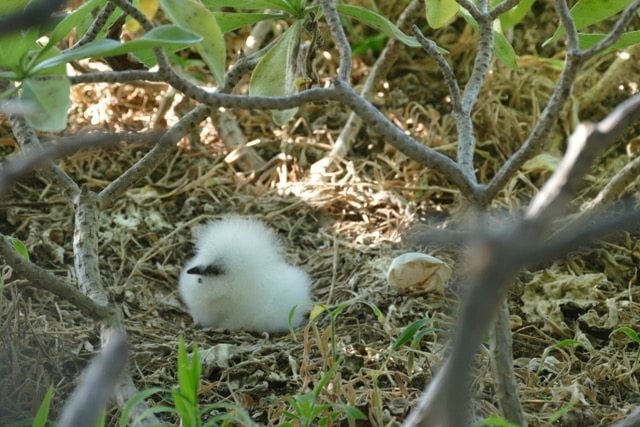
They are such beautiful birds and such dedicated nesters that visitors to Lady Elliott Island can approach them closely—sometimes too closely, we thought, as we watched from our porch. They are wonderful ambassadors for the world of birding. They tolerate people creeping close and pointing cameras at them, and they appear tranquil, as if human interference were just one more indignity of life on land as opposed to their glorious life at sea. But we didn’t know that at least one bird had been problem-solving as the small colony expanded.
Lady Elliot’s tropicbirds are a tremendous conservation success story—on a par with some of GGBA’s successes, such as its work with Snowy Plovers. Before human arrival there was surely a breeding colony on the island, but in the mid-nineteenth century Queensland sold a ten-year lease on the island to people who wanted to mine its guano—big business then. (As a measure of how big a business it was, consider this: When Queensland gained its independence from New South Wales, its entire financial reserves totaled 7 ½ shillings, while the initial offer for the guano mining rights was £300 per year.)
The miners spent ten years on the island, and during that time stripped it nearly bare of vegetation. Only eight of the original pisonia trees were left. Its bird population plummeted. What little vegetation remained barely sustained the wild goats the government provided as a supplemental food supply for the lighthouse keeper in the century after the miners left.
In 1969 the island was again leased out by the Queensland government—this time to Don Adams, whose plans were quite different than those of the miners. He agreed to build an airstrip on the island in exchange for a tourist recreation lease. He realized that the island would attract more tourists if it were green instead of grey, so he shot the goats and began planting trees and shrubs. The octopus bush under which our bird was nesting was one of these introductions. In the years that followed, birds began returning to the island in great numbers. And in 1983, the first Red-tailed Tropicbird chick was born. There are now as many as six birds nesting at a time, and, because of the mild winters, birds sometimes will raise two broods in a year. (As many of our Bay Area birds do: Anna’s Hummingbirds have been known to have as many as three broods in a year.)
Our third night on Lady Elliot this July was marked by a loud screechy ruckus. When we woke up, Susan asked me if any shearwaters might still be around. At Christmas, shearwaters nest in burrows just behind our room. They come in from sea late at night and their hungry chicks can make quite a racket as they greet their parents. But a check with the island naturalist confirmed that the shearwaters had left months ago.
So what WAS the noise we were hearing that night? Buff-banded Rails were sometimes active at night but this was a louder, deeper squawking than a rail’s. It actually sounded like the exchange that tropicbirds on nests have with their mates.
Later that morning when the naturalist came by to check on the nests, I learned that “our” bird—the one in front of our room—was in fact the second one to hatch a chick. Meanwhile, another bird had lost an egg and two others were still sitting on theirs. Two others? Yes, two.
We knew about one of the sitting birds, but where was the other? “It’s right under your bedroom,” she told us.
And then she took us around the back and showed us. The units are built about two feet off the ground. We peered between the slats that masked the no-man’s-land under the unit. There in the shadows was another bird sitting on her nest—directly under our bed. It turns out the simplest explanation was the correct one—a tropicbird conversing with its returning mate, not a small child being strangled. (No wonder the management puts earplugs on every bedside table.)

On our last day at Lady Elliot, there were still two eggs that hadn’t hatched. These would follow soon. Fledging, however, would take longer—tropicbirds are semi-altricial and nidiculous, meaning they appear underdeveloped at birth and stay with their parents for a long period of time. In this case, that’s anywhere from two and a half to four months. Perhaps it was a good thing for our sleep that the bird under our bed was still incubating her egg. Those bedside earplugs were going to be very necessary.
And then to top things off I noticed that one of the two Eastern Reef Herons, which had been hanging about the beach in front, had a long twig in its bill. And so did the other one. These two were an odd couple—a grey morph and a white one. And they were nest- building, also in front of our porch. It was definitely time to get on the plane.

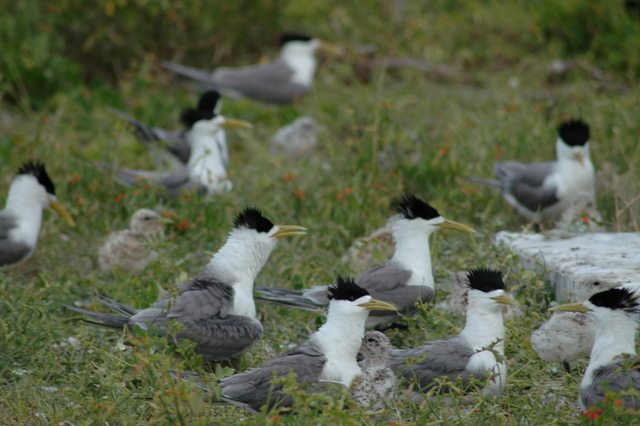
Eric Schroeder is a retired UC Davis lecturer and administrator who still leads month-long Summer Abroad student program for UCD in South Africa and Australia. He enjoys viewing wildlife in the sky, on land, and under the sea. He’s a recent graduate of the Master Birding Program jointly sponsored by the Golden Gate Bird Alliance and the California Academy of Sciences. He has previously written for Golden Gate Birder on Bewick’s Wrens, his first experience with Birdathon, and the blackbird nest on his horse trailer.
